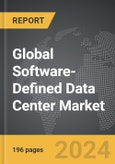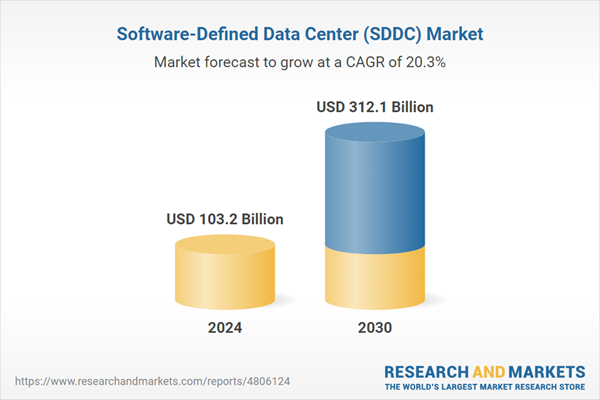The global market for Software-Defined Data Center (SDDC) was valued at US$103.2 Billion in 2024 and is projected to reach US$312.1 Billion by 2030, growing at a CAGR of 20.3% from 2024 to 2030. This comprehensive report provides an in-depth analysis of market trends, drivers, and forecasts, helping you make informed business decisions. The report includes the most recent global tariff developments and how they impact the Software-Defined Data Center (SDDC) market.
Segments: Component (Hardware, Software, Services); Type (SDC, SDS, SDDCN, Other Types); End-User (IT-Enabled Services, BFSI, Healthcare, Government, Retail & eCommerce, Other End-Uses).
Geographic Regions/Countries: World; United States; Canada; Japan; China; Europe (France; Germany; Italy; United Kingdom; and Rest of Europe); Asia-Pacific; Rest of World.
The analysts continuously track trade developments worldwide, drawing insights from leading global economists and over 200 industry and policy institutions, including think tanks, trade organizations, and national economic advisory bodies. This intelligence is integrated into forecasting models to provide timely, data-driven analysis of emerging risks and opportunities.
Global Software-Defined Data Center (SDDC) Market - Key Trends and Drivers Summarized
Why Are Software-Defined Data Centers Becoming a Strategic Priority for Enterprises?
Software-Defined Data Centers (SDDCs) represent a transformative approach to data center management by virtualizing and abstracting all data center resources - compute, storage, and networking - through software. This model offers unprecedented flexibility, scalability, and automation, enabling enterprises to manage their data centers more efficiently. SDDCs allow for seamless integration with cloud environments, providing a unified platform for managing on-premises, private, and public cloud resources. As organizations face the growing complexity of managing hybrid and multi-cloud environments, SDDCs provide a solution that enhances agility, reduces costs, and supports rapid application deployment. Industries such as IT and telecom, BFSI, healthcare, and government are increasingly adopting SDDC solutions to modernize their data centers, improve resource utilization, and ensure business continuity in a highly competitive landscape.How Are Technological Advancements Enhancing Software-Defined Data Center Solutions?
Technological advancements in automation, AI, machine learning, and orchestration are significantly enhancing Software-Defined Data Center solutions. Modern SDDC platforms leverage AI-driven analytics to provide real-time insights into data center operations, enabling predictive maintenance, automated workload balancing, and optimized resource allocation. The integration of Software-Defined Networking (SDN) and Software-Defined Storage (SDS) within SDDC architectures is enhancing network agility and storage scalability, supporting diverse workloads and applications. The rise of hyper-converged infrastructure (HCI) is also contributing to the growth of SDDCs by integrating compute, storage, and networking into a single, software-driven solution. Additionally, advancements in cloud-native technologies, such as containers and microservices, are driving the demand for SDDCs that can support next-generation applications with greater agility and efficiency.Which Market Segments Are Accelerating the Adoption of Software-Defined Data Centers?
Components of SDDC solutions include software-defined compute, software-defined storage (SDS), software-defined networking (SDN), and automation and orchestration tools, with SDS and SDN holding significant market shares due to their importance in data center virtualization. Deployment models are categorized into on-premises and cloud-based, with cloud-based SDDC solutions gaining traction due to their flexibility, scalability, and lower total cost of ownership. Organization sizes are divided into small and medium-sized enterprises (SMEs) and large enterprises, with large enterprises leading the market due to their complex IT environments and need for robust data management solutions. End-use industries comprise IT and telecom, BFSI, healthcare, retail, and government, with IT and telecom dominating the market due to their extensive data center needs. Geographically, North America is the largest market for SDDC, while Asia-Pacific is experiencing rapid growth due to increasing digital transformation and cloud adoption.What Are the Key Drivers of Growth in the Software-Defined Data Center Market?
The growth in the Software-Defined Data Center market is driven by several factors, including the rising demand for data center virtualization, technological advancements in AI and automation, and the increasing adoption of hyper-converged infrastructure. The need to reduce data center footprint, enhance energy efficiency, and improve scalability is driving the adoption of SDDC solutions across various sectors. Technological innovations in software-defined networking, storage, and orchestration tools are enhancing the efficiency and agility of SDDC platforms, supporting market growth. The expansion of cloud-native applications and the growing emphasis on end-to-end data center automation and orchestration are creating new opportunities for SDDC providers. Additionally, the focus on integrating AI-driven analytics, improving disaster recovery capabilities, and enhancing data center security is further propelling the growth of the Software-Defined Data Center market.Report Scope
The report analyzes the Software-Defined Data Center (SDDC) market, presented in terms of units. The analysis covers the key segments and geographic regions outlined below.Segments: Component (Hardware, Software, Services); Type (SDC, SDS, SDDCN, Other Types); End-User (IT-Enabled Services, BFSI, Healthcare, Government, Retail & eCommerce, Other End-Uses).
Geographic Regions/Countries: World; United States; Canada; Japan; China; Europe (France; Germany; Italy; United Kingdom; and Rest of Europe); Asia-Pacific; Rest of World.
Key Insights:
- Market Growth: Understand the significant growth trajectory of the Hardware segment, which is expected to reach US$150.9 Billion by 2030 with a CAGR of a 19.2%. The Software segment is also set to grow at 20.1% CAGR over the analysis period.
- Regional Analysis: Gain insights into the U.S. market, valued at $28.9 Billion in 2024, and China, forecasted to grow at an impressive 19.2% CAGR to reach $47.1 Billion by 2030. Discover growth trends in other key regions, including Japan, Canada, Germany, and the Asia-Pacific.
Why You Should Buy This Report:
- Detailed Market Analysis: Access a thorough analysis of the Global Software-Defined Data Center (SDDC) Market, covering all major geographic regions and market segments.
- Competitive Insights: Get an overview of the competitive landscape, including the market presence of major players across different geographies.
- Future Trends and Drivers: Understand the key trends and drivers shaping the future of the Global Software-Defined Data Center (SDDC) Market.
- Actionable Insights: Benefit from actionable insights that can help you identify new revenue opportunities and make strategic business decisions.
Key Questions Answered:
- How is the Global Software-Defined Data Center (SDDC) Market expected to evolve by 2030?
- What are the main drivers and restraints affecting the market?
- Which market segments will grow the most over the forecast period?
- How will market shares for different regions and segments change by 2030?
- Who are the leading players in the market, and what are their prospects?
Report Features:
- Comprehensive Market Data: Independent analysis of annual sales and market forecasts in US$ Million from 2024 to 2030.
- In-Depth Regional Analysis: Detailed insights into key markets, including the U.S., China, Japan, Canada, Europe, Asia-Pacific, Latin America, Middle East, and Africa.
- Company Profiles: Coverage of players such as Cisco Systems, Inc., Citrix Systems, Inc., EMC Corporation, Fujitsu Ltd., Hitachi Ltd. and more.
- Complimentary Updates: Receive free report updates for one year to keep you informed of the latest market developments.
Some of the 46 companies featured in this Software-Defined Data Center (SDDC) market report include:
- Cisco Systems, Inc.
- Citrix Systems, Inc.
- EMC Corporation
- Fujitsu Ltd.
- Hitachi Ltd.
- Microsoft Corporation
- NEC Corporation
Tariff Impact Analysis: Key Insights for 2025
Global tariff negotiations across 180+ countries are reshaping supply chains, costs, and competitiveness. This report reflects the latest developments as of April 2025 and incorporates forward-looking insights into the market outlook.The analysts continuously track trade developments worldwide, drawing insights from leading global economists and over 200 industry and policy institutions, including think tanks, trade organizations, and national economic advisory bodies. This intelligence is integrated into forecasting models to provide timely, data-driven analysis of emerging risks and opportunities.
What’s Included in This Edition:
- Tariff-adjusted market forecasts by region and segment
- Analysis of cost and supply chain implications by sourcing and trade exposure
- Strategic insights into geographic shifts
Buyers receive a free July 2025 update with:
- Finalized tariff impacts and new trade agreement effects
- Updated projections reflecting global sourcing and cost shifts
- Expanded country-specific coverage across the industry
Table of Contents
I. METHODOLOGYII. EXECUTIVE SUMMARY2. FOCUS ON SELECT PLAYERSIII. MARKET ANALYSISIV. COMPETITION
1. MARKET OVERVIEW
3. MARKET TRENDS & DRIVERS
4. GLOBAL MARKET PERSPECTIVE
UNITED STATES
CANADA
JAPAN
CHINA
EUROPE
FRANCE
GERMANY
ITALY
UNITED KINGDOM
REST OF EUROPE
ASIA-PACIFIC
REST OF WORLD
Companies Mentioned (Partial List)
A selection of companies mentioned in this report includes, but is not limited to:
- Cisco Systems, Inc.
- Citrix Systems, Inc.
- EMC Corporation
- Fujitsu Ltd.
- Hitachi Ltd.
- Microsoft Corporation
- NEC Corporation
Table Information
| Report Attribute | Details |
|---|---|
| No. of Pages | 196 |
| Published | April 2025 |
| Forecast Period | 2024 - 2030 |
| Estimated Market Value ( USD | $ 103.2 Billion |
| Forecasted Market Value ( USD | $ 312.1 Billion |
| Compound Annual Growth Rate | 20.3% |
| Regions Covered | Global |









